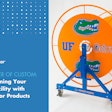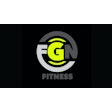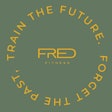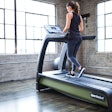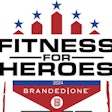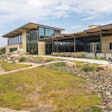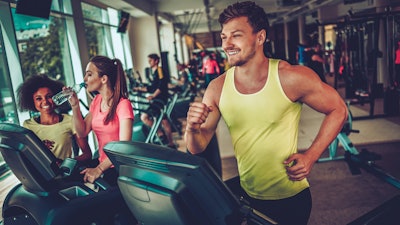
In Mt. Pleasant, Wis., owners of Razor Sharp Fitness decided to downsize an underutilized gymnasium by half in favor of heavy-duty strength equipment. In New Orleans, substantial square footage devoted to tables and chairs at Ochsner Fitness Center’s food and beverage bar will soon be gobbled up by the adjacent and ever-expanding strength training floor.
These facilities — measuring 47,000 square feet and 160,000 square feet, respectively — can’t find enough room to accommodate strength training, and they may be indicative of a broader trend in which Olympic racks, kettlebells and other resistance modalities are muscling their way into club members’ exercise routines — and clubs’ fitness floor layouts — like never before.
According to Fitness Industry Supplier Association data, strength equipment sales are up 181% over the past decade, whereas sales of two traditional cardio staples — stationary bikes and ellipticals — are down 58% and 43%, respectively. But if you think cardio exercise is flatlining, consider that a Market Research Future report published in December predicts commercial cardio equipment’s market share to reach $6.5 billion by 2032, up from $4.5 billion as recently as 2023. Commercial strength training equipment, meanwhile, is projected to grow at a less robust pace — from $3 billion in 2023 to $4.2 billion in 2032.
With the crystal ball sufficiently cloudy, AB asked personal trainers to describe what they’re experiencing in their workplaces, and some common themes emerged.
Strength’s major gains
Jordan Scott Reyes is a personal trainer at H4 Training in Wheaton, Ill., as well as a member of LA Fitness. “I do see a shift, especially in women,” says Reyes, who adds that commercial gyms that once offered a single squat rack on a floor otherwise full of machines might have as many as 10 racks today. “And it’s not only the big muscle-head men who use squat racks. A lot of women have been drawn to strength training, as well.
“In my opinion, a healthy body requires a healthy metabolism. The building block of metabolism is muscle, and the most efficient way to build muscle is through strength training.”
That said, Reyes still sees a lot of treadmill use, but also a rising popularity in rowing machines and ski ergs — the kind of health club equipment used in HYROX events, a recent fitness fad that includes cardio- and strength-based challenges throughout a timed race.
The functional fitness movement has also consumed significant square footage in a lot of commercial fitness locations. “There is still cardio equipment, obviously, and there are more squat racks, but then there is more functional fitness equipment, too,” Reyes says. “You’ll always see turf with a sled, TRX straps, medicine balls and kettlebells. Every LA Fitness has added that to their facilities.”
At Razor Sharp Fitness, Jacob Thomas and his wife served as personal trainers for nearly a decade before buying the club three years ago. He, too, has seen a transition. “Cardio was obviously a really big piece of the puzzle,” Thomas says. “From a timeline standpoint, it really started switching after COVID. It was already starting to switch, but then it really changed. People found other ways to do cardio on their own at that time. Because they couldn’t get in the gym, they found bike riding, running, pickleball, basketball — more recreational ways to do cardio. Most of them didn’t have treadmills and ellipticals in their house, but they might have had a free weight or two. I think people really started gravitating toward that kind of training because it was a little bit more accessible.”
The trend persists to this day, according to Thomas. “There was probably a lingering effect of how close you want to be next to each other for 30 minutes, no matter how far equipment is spaced out on a cardio deck,” he says. “I think even when people came back, they almost steered away from that space a little bit.”
From an industry standpoint, Thomas says new club members are “so much younger, and those people are looking for more strength training. They aren’t necessarily looking for cardio pieces, so those cardio pieces are kind of aging out a little bit.”
That explains the decision to reduce his club’s two-court gym to a single court. “Everything we put in there was plate-loaded, whether it was squat racks, Hammer Strength, Smith machines,” Thomas says. “Ultimately, this year, it’s turning into a full lower-body plate-loaded area only.”
Meanwhile, the cardio deck at Razor Sharp Fitness, while not expanding in terms of number of pieces, is trending toward innovation and performance-minded training — an Octane Lateral X Crosstrainer might replace a traditional elliptical, for example. “As our cardio pieces got a little bit older and essentially aged out, instead of just replacing those with like ones, what we’ve been doing is trading those out,” Thomas says. “The rowers, Airdyne bikes, Woodway curved treadmills — those are the ones that we brought in.”

VO2max revolution
Regardless of which fitness modalities members appear to be gravitating toward, personal trainers who spoke to AB emphasize the growing awareness and importance of an individual’s aerobic capacity.
“The clients that I have currently and my new clients are generally very well informed about what they’re looking for out of training,” says Josh Berkovic, a performance coach at Diakodi, a top private training facility in one of the nation’s healthiest cities, San Francisco. Diakodi features all the training amenities of a high-end health club, with two floors offering everything from synthetic turf to Olympic racks. “I’ve seen a huge trend in folks looking for training that’s focused on increasing health span and longevity, and in that regard, people are then focused almost equally on building and sustaining adequate muscle mass through strength training, and at the same time a lot of folks are very intelligently interested in achieving and sustaining a high VO2max, which is a great indicator of aerobic capacity and cardiovascular health.”
Berkovic explains that VO2max is the maximum amount of oxygen one can consume and apply to physical exertion. It’s a testable number that can improve with strength training, as research has pointed out, but more commonly through cardio exercise.
“Controlled, continuous intensity of cardiovascular training is the best way to train, specifically, and you want to be focused on your metabolic zone while you’re training,” Berkovic says, explaining that zones are based on heart rate and can be established for individuals through clinical testing, as well as estimation using wearables such as Apple Watch and Garmin, or heart-monitoring wristbands like those from platforms Peloton and WHOOP. “Generally, folks are going to be looking to perform 80% of their cardiovascular training at Zone Two of their metabolic training zones. Zone Two is a completely aerobic energy state at which you’re oxidizing the maximum amount of fat as fuel and also clearing lactic acid from the body. And it’s fairly low intensity.”
Moreover, mitochondria — the body’s energy producers at the cellular level — are not only individually strengthened but multiplied through this process.
“VO2max is a test of how well your body utilizes oxygen, so when your cardio fitness increases, you are able to utilize oxygen more efficiently and more effectively,” says Dustin Millhollen, a personal trainer at Mazama Wellness, also in San Francisco. “And that just has a benefit on the cells, on the mitochondria in the cells, and so that has a really impressive overall benefit to individual health.”
A brisk walk is enough to keep most people in Zone Two, according to Berkovic, who adds, “Generally, any piece of cardio equipment that you’re going to find at a training facility is going to offer you the opportunity.”
That said, he favors two types of equipment, in particular. One is the air-resistance bike. “I think those are absolutely fantastic for cardiovascular training,” he says. “They’re obviously more full body than just a stationary bike, because you’re utilizing your upper body to push and pull the handles as you’re using your lower body, so they’re really great to get that full-body exposure. And treadmills are fantastic. However, treadmills are really a little bit less safe than the bikes, because you have, of course, the impact of the running on your joints, and you want to make sure that your biomechanics are sound, even at high levels of fatigue.”
Millhollen agrees. “A lot of times, people have never been coached on how to run, and they probably should be in order to protect their joints,” he says. “If I throw someone on an air bike, I don’t really need to coach them in the movement, and I don’t need to worry so much about them hurting themselves, because it would be really hard for them to do that, whereas running, especially if we’re getting into interval training, where you’re pushing the intensity, it can be much, much easier for someone to hurt themselves in that situation.
“I really like to use an air bike for any sort of interval training, because it’s very effective and it really doesn’t take too much time to elevate the heart rate and get people breathing hard.”
Exercisers can also use traditional stationary bikes, rowers or climbers to work out in Zone Two or Five, or both. The key is that Zone Two work must be sustained, often preceding — but not uninterrupted by — the short, intense Zone-Five sessions. (Zones Three and Four, while useful in training for a distance running event, are not necessary for improving VO2max, and in fact produce lactic acid and other harmful byproducts in the body.)
“You want to stay at Zone Two at that lower intensity 180 to 200 minutes per week,” Berkovic says. “On the flip side of that, you do want to hit your max intensity — essentially training at around your VO2 maximum — for the other 20 percent of your training. Zone Five training — from 95% to 100% of your maximum heart rate — would be done in much shorter intervals. Two to four minutes would be perfect for any person who’s training, even higher-level athletes, with a one-to-one work-to-rest ratio. So, you would train for two minutes, rest for two, train for three, rest for three, train for four, rest for four.”
The studio settings in which Millhollen works might include a treadmill, an aerodyne bike, a rowing machine, a ski erg and a climbing machine, but he notices them being used mostly for warm-ups and cooldowns. “Most people don’t want to pay an hourly rate for someone to just be there while they do cardio,” he says.
Walking past his local 24 Hour Fitness, however, Millhollen frequently notices a variety of cardio equipment in use. “Honestly, I see a lot of people using it,” he says. “It’s ellipticals, it’s treadmills, it’s stationary bikes, and I think a lot of people are still happy with using those pieces of equipment and watching a Netflix show on a screen while they do it. Obviously, that’s kind of a different environment than what I’m used to, but I still feel like that’s ideal for some people.”
Individuals exercising to slow the aging process will find that with consistent cardio exercise, they can maintain a VO2max number that closely rivals that of someone decades younger.
“Strength and muscle mass are harder to gain as you get older. Ideally, you’d want to put on a bunch of muscle and get strong when you’re younger and then maintain that strength into old age,” Millhollen says. “But I think the cardiovascular training is super important, and right now there’s a big emphasis on VO2max. There’s a lot of research to show that improving your VO2max has an inverse correlation with all-cause mortality. People who have a higher VO2max are dying less from cardiovascular disease, from metabolic diseases and from cancer. There’s just a lot of research to show that cardiorespiratory health is super important — I would say just as important as keeping muscle mass and your bone density and your strength.”
Balanced approach
Berkovic references one book in particular titled Outlive: The Science & Art of Longevity, by physician Peter Attia, and he summarizes Attia as espousing a two-pronged approach to sustained health. “You have a high VO2max and are adequately strong, relative to your age demographic,” Berkovic says. “It’s really made it into the popular Zeitgeist where folks are saying, ‘That sounds like exactly what I want. I want to have health span and longevity, and now I’m seeing a very actionable plan about how to get it, and I know that that is supported by clinical research.’ ”
“I do think it’s a balance,” Reyes says. “It just depends on the individual’s goals. Cardio, depending on how you use it, could be a mental health tool — to get outside in nature and knock out some miles, just to be present. And they could help each other out. Cardio could help strength training by improving the cardiovascular system. With running, that’s only one plane of motion that’s just going forward. It’s not going backward. It’s not going side to side. That repetitive pounding on the body in one plane of motion is where we can get injuries. And to prevent those injuries and to help people run longer and healthier, strength training is absolutely crucial. So, they help each other out.”
Millhollen admits his own philosophy has evolved. “I was always of the mindset that strength training is a priority, and then get some movement — some low-intensity cardio is fine. Walking is fine. But with all this research around VO2max, the best way to improve VO2max, they found, is high-intensity intervals. The high-intensity intervals can be super beneficial for VO2max, and that can be done on an air bike, that can be done running, that can be done in a lot of different ways.
“In the arenas that I’m in, I feel like there’s this recognition that there needs to be a balance of the two. I almost feel like it’s kind of going back to where it’s going to be a little more evenly split.”
Thomas has melded the two fitness approaches by investing in EGYM’s Smart Strength and Smart Cardio modalities, which allow for integration with connected brands — Matrix, in the case of Razor Sharp Fitness. “The nice thing for us is we’re able to give people cardio assessments,” Thomas says. “We can do a VO2max test on it. They can do their workouts and be integrated inside of the system, so we can understand essentially what their bio age is. Where is their threshold for their cardio, and how we can make an impact in that? It’s another way to create a measurable result for cardio, because it’s integrated. I think you’re going to see more integrations on how cardio can continue to be an important part, but also be able to measure it and track it better.”
The fitness industry — and its followers — are becoming more educated than ever.
“With my client base, I’m seeing — and I’m happy to see — a growing interest in a balanced approach to training that really incorporates both intelligent cardiovascular training and intelligent strength training,” says Berkovic, a former professional mixed martial artist. “I’ve seen athletes, even at a super-high level, make the mistake in their own training journey of indexing one specific type of training to the detriment of the other. I think that is a big error in your training philosophy and training approach overall, because we need both. We literally need both, not just to optimize for our health span and longevity, but also to optimize our performance.”

























